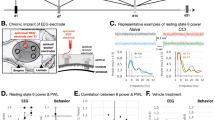Abstract
We have developed a chronically instrumented rat model that uses changes in electroencephalographic waveforms to estimate continuously the degree of central nervous system (CNS) depression induced by thiopental. Such changes were subject to aperiodic signal analysis, a technique that breaks down the complex EEG into a series of discreet neurologic “events” which are then quantitated as waves/sec. We thus obtained a continuous measure of CNS drug effect. In addition we continuously recorded central arterial blood pressure and heart rate and monitored ventilatory status using arterial blood gas determinations. We also determined, with frequent arterial blood sampling, the distribution and elimination of thiopental in individual animals. The time lag occurring in the curve representing arterial concentration of thiopental vs. EEG effect suggests that arterial plasma is not kinetically equivalent to the EEC effect site. Application of semiparametric pharmacodynamic modeling techniques enabled us to estimate equilibration rate constant (Keo for concentrations of thiopental between arterial plasma and the effect site. The half-life for equilibration of thiopental with the EEG (CNS) effect was less than 80 sec. Knowledge of the rate of equilibration permitted characterization of the relationship between the steady state plasma concentrations and CNS effect of thiopental, as measured by activation and slowing of the EEG. At concentrations of thiopental below 5 gmg/ml, EEG activity was 180% higher than during the baseline awake state. Thiopental produced an activated EEG over more than 20% of the concentration-effect relationship. Further increases in the concentration of thiopental at the site of effect depressed EEG activity progressively until complete suppression of the EEG signal occurred (at which time, the concentration was approximately 80 μg/ml). This report describes our model and its application to the assessment of the pharmacodynamics of thiopental as manifested by changes on the EEG.
Similar content being viewed by others
References
M. Danhof and G. Levy. Kinetics of drug action in disease states. I. Effects of infusion on phenobarbital concentrations in serum, brain and cerebrospinal fluid of normal rats at onset of loss of righting reflex.J. Pharmacol. Exp. Ther. 229:33–50 (1984).
M. Danhof and G. Levy. Kinetics of drug action in disease states. V. Acute effects of urea on phenobarbital concentrations in rats at loss of righting reflex.J. Pharmacol. Exp. Ther. 232:430–434 (1985).
M. Danhof and G. Levy. Kinetics of drug action in disease states. II. Effect of experimental renal dysfunction on phenobarbital concentrations in rats at onset of loss of righting reflex.J. Pharmacol. Exp. Ther. 230:627–631 (1984).
S. Wonwimolruk and G. Levy. Kinetics of disease states. XX. Effect of acute starvation on the pharmacodynamics of phenobarbital, ethanol and pentylenetetrazol in rats and effect of refeeding and diet composition.J. Pharmacol. Exp. Ther. 242:166–172 (1987).
G. Wahlström. Estimation of sensitivity to hexobarbitone (enhexymal NFN) in rats by a threshold.Acta Pharmacol. Toxicol. 24:404–418 (1966).
G. Wahlström. Hexobarbitone sleeping time in rats following doses with similar EEC changes.Acta Pharmacol. Toxicol. 24:419–434 (1966).
N. H. G. Holford and L. B. Sheiner. Understanding the dose-effect relationship: Clinical applications of pharmacokinetic-pharmacodynamic models.Clin. Pharmacokin. 6:429–453 (1981).
D. Verotta and L. B. Sheiner. Simultaneous modeling of pharmacokinetics and pharmacodynamics: An improved algorithm.CABIOS 3:345–349 (1987).
E. Fuseau and L. B. Sheiner. Simultaneous modeling of pharmacokinetics and pharmacodynamics with a nonparametric pharmacodynamic model.Clin. Pharmacol. Ther. 35:733–741 (1984).
N. Khazan, R. Bar, and F. G. Sulman. The effect of cholinergic drugs on paradoxical sleep in the rat.Int. J. Neuropharmacol. 6:279–282 (1967).
S. F. Flaim, S. H. Nellis, E. J. Toggart, H. Drexler, K. Kanda, and E. D. Newman. Multiple simultaneous determinations of hemodynamics and flow distribution in conscious rat.J. Pharmacol. Methods 11:1–39 (1984).
W. F. Ebling, L. Mills-Williams, S. R. Harapat, and D. R. Stanski. A high-performance liquid chromatographic method for determining thiopental concentrations in twelve rat tissues: Application to physiologic modeling of disposition of barbiturate.J. Chromatog. 490:339–353 (1989).
T. K. Gregory and D. C. Pettus. An electroencephalographic processing algorithm specifically intended for analysis of cerebral electrical activity.J. Clin. Monitor. 2:190–197 (1986).
M. L. Rocci and W. J. Jusko. LAGRAN Program for area and moments in pharmacokinetic analysis.Comput. Prog. Biomed. 16:203–216 (1983).
N. A. Lassen and W. Perl. InTracer Kinetic Methods in Medical Physiology, Raven Press, New York, 1979, pp. 62–101.
L. B. Sheiner. ELSFIT-A program for the extended least squares fit to individual pharmacokinetic data. Technical Report, Division of Clinical Pharmacology, University of California, San Francisco, CA, February 1981.
M. Gibaldi and D. Perrier. InPharmacokinetics, 2nd ed., Marcel Dekker, New York, 1982, p. 68, Eq. 2.69.
W. D. Winters. A review of the continuum of drug-induced states of excitation and depression.Prog. Drug. Res. 26:225–258 (1982).
M. C. Demetrescu. The aperiodic character of the electroencephalogram.Physiologist 18:189 (1975).
T. D. Homer and D. R. Stanski. The effect of increasing age on thiopenta! disposition and anesthetic requirement.Anesthesiology 62:714–724 (1985).
L. K. Paalzow and P. O. Edlund. Multiple receptor responses: A new concept to describe the relationship between pharmacological effects and pharmacokinetics of a drug: Studies on clonidine in the rat and cat.J. Pharmacokin. Biopharm. 7:495–510 (1979).
J. Mandema and M. Danhof. Pharmacokinetic-pharmacodynamic modeling of the central nervous system effects of heptabarbital using aperiodic EEG analysis.J. Pharmacokin. Biopharm. 18:459–481 (1990).
Y. Igari, Y. Sugiyama, S. Awazu, and M. Hanano. Comparative physiologically based pharmacokinetics of hexobarbital, phenobarbital and thiopental in the rat.J. Pharmacokin. Biopharm. 10:53–74 (1982).
Author information
Authors and Affiliations
Additional information
Supported by grant RO1-AGO4594 from the National Institute on Aging, National Institute of Health; and the Anesthesia/Pharmacology Research Foundation.
Rights and permissions
About this article
Cite this article
Ebling, W.F., Danhof, M. & Stanskl, D.R. Pharmacodynamic characterization of the electroencephalographic effects of thiopental in rats. Journal of Pharmacokinetics and Biopharmaceutics 19, 123–143 (1991). https://doi.org/10.1007/BF01073865
Received:
Revised:
Published:
Issue Date:
DOI: https://doi.org/10.1007/BF01073865




